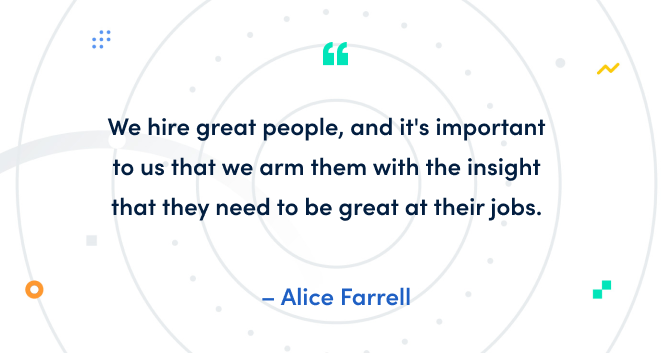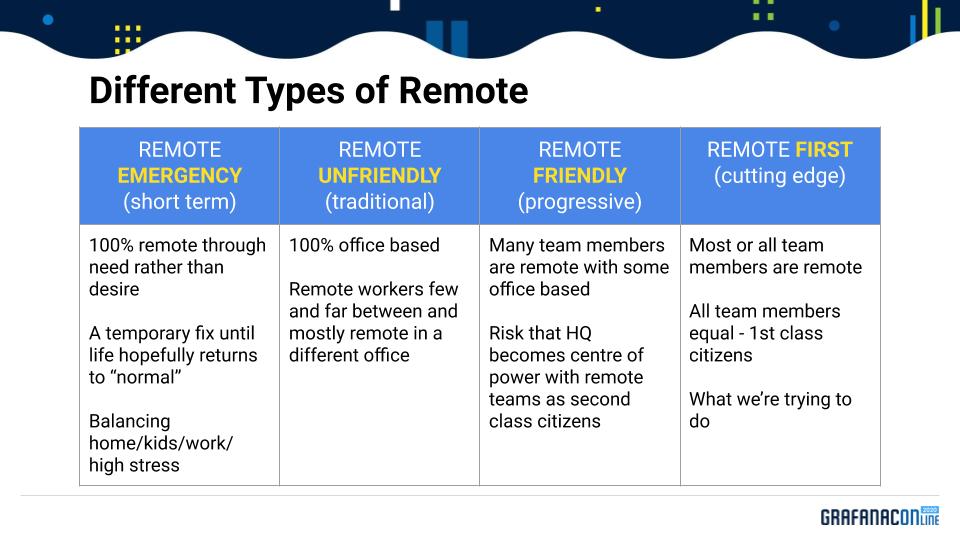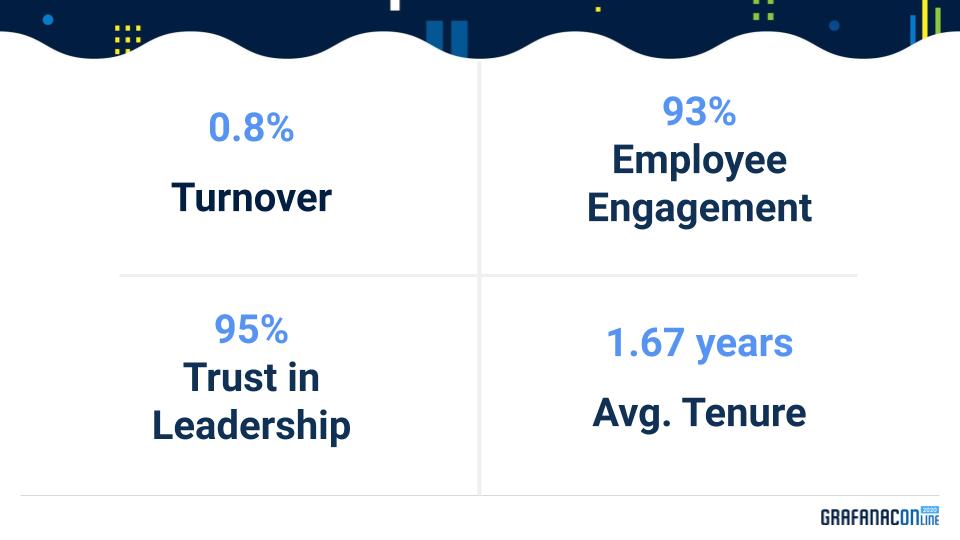
Grafana Labs' secrets to building and supporting a happy team
Grafana Labs is incredibly proud to have made Inc.’s 2020 list of Best Workplaces, an honor that is based directly on the results of a team member survey. Of the Grafanistas who responded to it, 98 percent reported they’re happy with their jobs and proud to work for the company.
Building a company that supports – and retains – its team members is at the core of Grafana Labs’ mission. And during the closing presentation of GrafanaCONline, Alice Farrell, VP, People Ops, explained exactly how it’s done.
The key pieces include bringing in a people ops team during the early startup stage, being remote-first and creating a culture that supports team members. All of those factors have contributed to Grafana Labs’ growth over the past few years.
There’s supposed to be a video here, but for some reason there isn’t. Either we entered the id wrong (oops!), or Vimeo is down. If it’s the latter, we’d expect they’ll be back up and running soon. In the meantime, check out our blog!
People Ops basics
As the VP of People Ops, Farrell’s job is to oversee recruitment, hiring, and all things that traditionally fall into the category of human resources – plus more. “I help Grafana Labs to meet our hiring targets, to welcome new Grafanistas to the team and try to help build a company that means that they want to stay for the long term,” she said.
Farrell has worked in tech startups for almost 15 years, and has worked remotely for nine years. She joined Grafana Labs in early 2019, when there were only 37 team members at the company. It was an unusual opportunity, since most startups that size usually leave people ops to the founders or an office manager until they reach a later stage with revenue growth. “It is, after all, a cost center,” she said.
Grafana Labs decided to invest in People Ops at such an early stage for many reasons, but as with any startup, Farrell said, “Getting those first few hires right is critical.”
People Ops, she explained, helps a new company focus on “how to define what ‘good’ looks like, where to find the talent, how to benchmark salaries, and how to transition what you’re looking for as the company scales from your first wear-lots-of-hats-and-just-get-stuff-done hires, right through to building out your leadership team and moving from generalist to more specialist roles.”
There’s constant iteration, and a People Ops program is there to “keep the performance bar high and the candidate experience really strong whilst you’re still growing at pace.”
Finding, hiring and retaining talent is one of the biggest challenges for a startup, she said. “Recruitment requires effort. It’s a real investment of time and budget to get it right.” Having a strong foundation helps ensure people stay for the long-term.
“Nothing hits your go-to-market motion harder than high turnover in the team,” she said. “So focus on hiring and onboarding and becoming an employer of choice early, and you’ll build that engaged and high-performing team.”
Along with Farrell, the Grafana Labs People Ops team members are Dasha Nikolov and Zach Choquette, who focus on hiring, and Hannah Sutton-Smith and Gracie Sharpe, who support the internal team.
They’re spread out across the U.S. and U.K., in order to provide coverage in the multiple time zones where Grafanistas work.
They focus on the following three areas:
Company culture
A welcoming and inclusive culture can have a significant impact on a company’s ability to grow.
Company culture “happens whether you plan it or not,” Farrell said, “but if you’re intentional about it and you take care to define it in a meaningful way, it can become a real differentiator in helping you to attract and to retain that hard-fought-for talent.”
Since Grafana Labs has a distributed team, the culture has nothing to do with ping pong tables and office snacks. “It’s really just how we go about our day and our shared set of norms,” she explained.
The company has a one-team mentality, which influences things like the way benefits are structured. Take the global 30-day annual leave policy, for example. “That’s super generous in the U.S. and relatively standard in parts of Europe,” she said. “But as a distributed team all pulling in the same direction, it’s really important to us that we offer the same benefits to the entire team.”
Support and engagement
Obviously, People Ops is about people, but it’s more than that. “It means building a strong company and ensuring the business has the right information to make strong data driven decisions,” Farrell said. “That’s true in any company, but especially so in a remote-first one, when your team is not in front of you.”
One important way People Ops keeps tabs on what’s happening is to base their people strategy “on information and not gut feel,” she said. “We spend time gathering data from the first point of contact with a candidate, right through to when an employee decides to leave the company.”
In between, they’re implementing programs to help support and develop the team and company culture. Those include continuous performance management and team member engagement surveys. “All of that is designed to help us make smarter decisions and to better support our team.”
Compliance
It’s not the “sexy” part of the job, “but it’s super important,” Farrell said. “Making sure you’ve got good documentation, tools and systems in place is crucial when you hit your first funding rounds, due diligence and/or compliance audits.”
She added, “It’s also just good practice and a legal requirement in most locations. So make sure it’s someone’s day job.”
The remote-first commitment
“Being a remote-first company is at the very heart of Grafana labs,” Farrell said. “It’s where we started. And as we’ve scaled, it’s something that we’ve explicitly recommitted to several times when we were worried it might be slipping away.”
She noted that a 2019 Zapier survey on the state of remote working found that 95 percent of U.S. knowledge-workers want to work remotely, and 74 percent would be willing to quit their current job to do so.
Top reasons why remote work is appealing:
- Flexibility to work from anywhere
- Cost savings
- More time with family, pets or loved ones
- Increased productivity working from home
As Farrell noted, much of the world is currently working remotely, and companies like Twitter and Facebook have announced plans to make it a permanent option for many of their employees.
There are a variety of ways to work remotely (see below), but she said people shouldn’t decide if they like it based on their experiences over the past few months. After all, many people not only had to balance work with homeschooling, but also couldn’t go anywhere because of lockdowns. “All of that contributes to much higher stress levels.”

It’s important to note that Grafana Labs is building a remote-first team, and isn’t simply remote-friendly. The difference? Remote-first means most, if not all, of the team is distributed. “That puts everyone on a level footing,” she said. “We think it’s important to call out the difference. We don’t pay lip service to being a distributed team when it’s convenient.”
The benefits
Grafana Labs has always been remote-first because founders Torkel, Raj and Anthony have always been located on different continents.
But it does have advantages:
Talent is global. “We can hire really smart people globally and improve our access to great team members and build a stronger, more diverse team as a result,” Farrell said.
The community and our customers are global. “It’s important to us that we’re able to mirror that. Many of our teams can take advantage of a follow-the-sun mode, and we all benefit in terms of getting to choose the environment that we get to work in and being happier and healthier people as a result.”
Recruitment is global. “As we scale the team, it’s been a real advantage to us to be able to recruit globally,” she said. “We’ve brought some great people into the business at a much faster pace than we would otherwise have been able to do had we been restricted to hiring within a commutable distance of an office. So it’s better enabled us to scale at pace.”
Grafana Labs does have some physical office spaces in Stockholm and New York. “They act as hubs for us to bring our distributed teams together for things like sprints, onboarding boot camps, and as spaces to collaborate,” Farrell explained. “We find that remote working works best when you get an opportunity to meet your colleagues in person to build trust and rapport, and so we try to invest heavily to facilitate that.”
Game-changing growth
In 2018, just 12 new people joined the Grafana Labs team, and it has been steadily growing since then. 2019 started with 35 team members and ended with 106.
“Our headcount moved us from being a pretty small startup at the beginning of the year to a proper company by the close,” Farrell said. “We built out our leadership team and really invested in building our R&D and commercial teams. And that growth is continuing this year.”
Currently, there are 152 team members, and more will continue to be hired. “We’re currently forecasting to end 2020 with just over 200 global team members,” she said. Most of those people will accept a role at Grafana Labs without meeting a single member of the team in person.
“That’s quite a leap of faith,” Farrell said, “and it’s why we’re trying to invest so heavily to make sure that we deliver a great candidate experience, so that people can get to the end of our process and find it easy to see the opportunity in front of them, despite not having met any of our team in person yet.”
At inception, team members were based in three different countries. At the start of 2019, they were in 11, and currently, there are team members in 29 different locations. Most are in North American and European time zones, but Farrell noted there are colleagues in South America, Hong Kong and Russia, not to mention others who are globe-trotting nomads.
Last October, Grafana Labs brought team members together in New York, Stockholm, Berlin and London to help celebrate the company’s fifth birthday.
Core values
Farrell boiled down the company’s success to a few key values and ways of operating:
“We share openly, and we default to transparency.”
Grafana Labs strives to be as open as possible, leading to regular team sprints, monthly all-hands calls and open sharing of documentation. The core intent is to make sure that the distributed team can work smarter and make better decisions. “That means that we place real trust in our teams to have the information that they need to make informed decisions,” she said. “We hire great people, and it’s important to us that we arm them with the insight that they need to be great at their jobs. And doing that is essential to making remote-first work well at Grafana Labs.”
“We are respectfully empowered.”
The culture at Grafana Labs doesn’t involve micromanagement and red tape. “We hire really smart people, and then we want to let them get on with the job which we hired them to do,” Farrell said. Because teams are in multiple time zones and communication is often asynchronous, teams are given the context they need to do their jobs, yet encouraged to be autonomous. Having “a really high trust dynamic” ensures all of that is possible.
“We believe in work + life, not work vs life.”
“At times that can definitely be aspirational,” Farrell said, “but it’s something that we’re really trying to focus on.” As many people have been learning, work-life balance can be hard to find when you’re doing your job from home. “Work can bleed into the beginning, middle and end of your day if you’re not really disciplined,” she said. Preventing burnout is key. “Working in a startup, it’s a marathon, not a sprint.”
Balance can look different from person to person, so one way the company supports team members is by not tracking hours. “We care much more about output and results than we do about hours at a desk,” Farrell explained.
“We are always a perpetual work in progress.”
Although the company has grown a lot, “our heart will always be a startup,” she said. “We love the semi-organized chaos of building a company. I think recognizing that is sometimes half the battle to making it work. We’ll likely go through multiple iterations of our normal and our structure before we stabilize.” As the company grows, the goal is to try to embrace change rather than be afraid of it.
Structure
In the future, Farrell said she expects Grafana Labs will become more structured. But she added, “At our core, we don’t want to entirely lose our startup roots.”
One of the company’s best perks, she said, is its “amazing” team. “That sounds a little cheesy, but we really do mean it. We’re really proud of the group of people we’re assembling, and our company and our culture is the team.”
That’s not just a feeling held by leadership. According to Farrell, team members have listed one of the company’s top perks as “getting to work with really interesting, smart, and open-minded people who are good at what they do because they’re passionate about it.”
Progression frameworks
Because of Grafana Labs’ swift growth, the company has had to evolve its structure earlier than planned. “We’re likely to need to do that again as we continue to scale,” Farrell said.
Since teams are getting bigger, the company is working on rolling out progression frameworks. “Progression frameworks are really just a way of turning a career into a series of steps,” she explained. “They’ve got multiple benefits, but the key one is helping our team invest in their career development so they can grow with us as we scale Grafana Labs.”
One of the core principles of this structure is a two-track system, as shown below. There are eight levels, and each track goes up to the same level of seniority.

One track is for individual contributors who may not be interested in people management as part of their career, and the other track is for specializing in people management. “Leadership at Grafana Labs comes in many forms, and we want to view people management as a career change as well as a promotion,” Farrell explained.
This year, the leadership team – which is made up of senior individual contributors plus management and senior management teams – has been expanding in order to add more people-management support.
“The data we’re collecting suggests that we’re on the right track,” she said. The turnover rate is low for a tech company (the industry average is between 10 and 15 percent), and a team member engagement survey also returned these positive results.

One important note: Five years in, most of the original team members are still with Grafana Labs. However, the average tenure at this point is just 1.67 years because 85 percent of the current team joined the company in the last two years.
Of course, there’s still room for more. “We’re hiring!” Farrell said.
Visit the careers page to learn about open opportunities at Grafana Labs.



